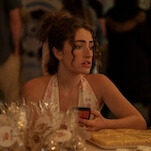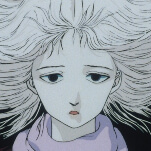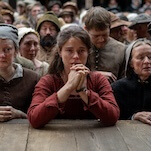Ostensibly, given the title, The Ballad Of Genesis And Lady Jaye is predominately about the relationship between P-Orridge (born Neil Megson) and Lady Jaye (born Jacqueline Breyer), who embraced each other so fully that they dressed alike, sported identical hair and makeup, and had multiple surgeries to more closely resemble each other. P-Orridge likens the process, dubbed “pandrogyne,” to an art project, to childbirth (two people in love producing a new single person, in this case themselves), to Burroughs’ cut-up technique, and to orgasm, when lovers briefly merge. But Losier covers a wide range of P-Orridge’s life, from school days as a diminutive, viciously bullied child to existence without Lady Jaye, who died in 2007. The reportage comes almost entirely in P-Orridge’s own words, often in voiceover placed over a stunning variety of archival footage and Losier’s footage of the couple’s day-to-day life, backed with Psychic TV tracks.
The Ballad Of Genesis And Lady Jaye isn’t a fans-only prospect by any means, but fans of experimental film, performance art, and Britain’s early industrial scene are most likely to recognize the players, follow the scattered chronology, and get excited about the fragmented, nervy approach. Losier hacks simple scenes into stuttering montages, and chops P-Orridge’s performances and interviews together with segments that have her lying on a table in a brightly colored costume, pretending to swim, or lying on her back, covered in paper butterflies, or standing in an alley dressed in black leather, black-and-white hair, and a Hitler mustache, screaming “I am so sick and tired of being told what I’m supposed to look like! This is not my body, this is not my name, this is not my personality!” At times, the film is visually and aurally overwhelming, a heady stew of rebellion and challenge that doesn’t take time to identify its figures, its era, or whether any given footage is one of Losier’s stylized interviews or one of P-Orridge’s performance-art pieces. The style is often distracting and discordant, and there’s always a sense of material and ideas left unexplored in the rush to get to the next thing. But Genesis And Lady Jaye accurately portrays a restless artist with a kitchen-sink aesthetic, and offers up a film to match.









































